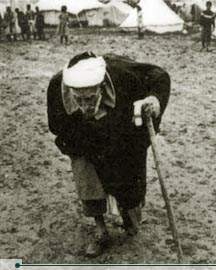 |
Keys
to the Kingdom National Anthem The Office History |
In early 1963, Israel announced its intention to divert part of the Jordan River waters to irrigate the Naqab Desert (also known as the Negev Desert). In response, Arab leaders decided at a 1964 Cairo summit to reduce the flow of water into Lake Tiberias by diverting some tributaries in Lebanon and Syria. To prepare for defense in case of an Israeli military response to these diversions, a joint Arab force was created. The United Arab Command was composed of Egyptian, Syrian, Jordanian and Lebanese elements, and was headed by Lieutenant-General Ali Amer of Egypt. |
 Third wave of Palestinian refugees after the 1967 war with Israel. © UNRWA |
| Another
outcome of the Cairo summit was the establishment of the Palestine Liberation
Organization. Concurring with other Arab leaders, King Hussein recognized the need for
an organization of this kind which could coordinate Palestinian efforts. His only concerns
were that the PLO should cooperate with Jordan and that its military activities should be
under the strict control of the United Arab Command, lest they should inadvertently drag
the Arabs into a war with Israel for which they were unprepared. The mid-1960s also saw the rise of independent Palestinian guerrilla groups (known in Arabic as the fedayeen), the most notable of which was Yasser Arafat’s Fatah movement. In their relentless attempts to outbid Nasser, the Ba’thist Syrian government encouraged guerrilla raids into Israel—not from Syria, but from Lebanon or Jordan. The Israeli reprisals to these militarily senseless raids were predictably harsh, and Jordan was forced to reign in the guerrillas. For this, Jordan was attacked again by the propaganda machines in Cairo, Damascus, and Baghdad. Responding to a fedayeen raid, on November 13, 1966, Israel launched a major attack on the West Bank border village of Samu, rounding up villagers and destroying their houses. A Jordanian armored column hastened to repel the attack, but was overwhelmingly defeated by the Israelis’ superior firepower. Instead of serving as an alarm warning of the dangers of uncoordinated military raids, the tragedy gave further grist to the opponents of the Hashemite Kingdom, who argued that the regime was responsible for what had happened at Samu. Radio broadcasts from Egypt, Syria and Iraq prompted rioting in major Jordanian cities. By the spring of 1967, the situation had become extremely intense. On May 16, Nasser shocked the world by asking the United Nations to withdraw its forces from Sinai. To the surprise of many, his request was honored two days later. Moreover, the Egyptian president closed the Straits of Tiran on May 22. Sensing that war was now likely, King Hussein aligned Jordan firmly with Egypt, suggesting an Egyptian-Jordanian Mutual Defense Treaty. Nasser immediately accepted the idea, and the treaty was signed on May 30. The treaty stipulated that Jordan’s forces were to be placed under the command of Egyptian General Abdul Moneim Riad. Iraq also signed the pact, while the Syrians denounced it and refused to sign. The outbidding and rivalry of radical Arab parties allowed Israel to launch a surprise attack on June 5, 1967, virtually eliminating the Egyptian air force in a single blow.14 At that point, the outcome of the war was decided. In response to the Israeli attack, Jordanian forces launched an offensive into Israel, but were soon driven back as the Israeli forces counterattacked into the West Bank and Arab East Jerusalem. After destroying the Egyptian air force, Israel had complete control of the skies, raining down deadly napalm bombs on the defenseless Arab forces. After a spirited defense of Arab East Jerusalem, the outnumbered and outgunned Jordanian army was forced to retreat to preserve the East Bank heartland against the Zionist expansion. When the final UN cease-fire was imposed on June 11, Israel stood in possession of a wide swath of Arab land, including the Egyptian Sinai, Syria’s Golan Heights, and, most significantly, what remained of Arab Palestine—the West Bank, including Arab East Jerusalem, and the Gaza Strip. Of the states participating in the conflict, Jordan paid by far the heaviest price. As a result of the war, more than 300,000 Palestinian Arabs became refugees and fled to Jordan. For many of them, this was the second uprooting in less than two decades, having been driven from their original homes in 1948. Jordan’s economy was also devastated. About 70% of Jordan’s agricultural land was located in the West Bank, which produced 60 to 65% of its fruits and vegetables. Half of the Kingdom’s industrial establishments were located in the West Bank, while the loss of Jerusalem and other religious sites devastated the tourism industry. Altogether, areas now occupied by Israel had accounted for approximately 38% of Jordan’s gross national product. Despite the economic devastation wrought by the war, Jordan continued to shoulder its previous administrative and financial responsibilities for the West Bank. It continued to pay the salaries and pensions of civil servants, while administering religious endowments or waqf and educational affairs. |